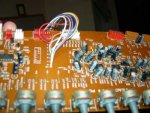LUNE
...a pieds joints
There are two different issues here. In practice I COULD work around the first (though it’d be nice to fix ‘er up right) and the second is rather more of a handicap in practice.
Issue #1:
Track 5 meter does not read on record function enabled (red light on track 5). So no monitoring of input regardless of what channel is used to assign to track 5. The actual input does work on both Line & mic in (channel 5) and I can record on track 5 fine enough (assigned from whatever channel). The VU meter does show signal on playback AND IT CONTINUES TO SHOW LEVEL ON TAPE EVEN WHEN THE TRACK 5 RECORD FUNCTION IS ENGAGED (which is when it should be reading the line/mic in).
Should I be looking on the Channel Rec/Play PCB boards? or could this be something in the record function section? Am I correct in my assumption that this would have to be an actual problem on a PCB board somewhere (dead Capacitor etc.) NOT just a mis-adjustment somewhere?
Issue #2:
Both the Aux & Effect outs produce a sort of muffled ‘oil in a frying pan’ sound. Maybe about 3-5 "plips" per second and erratic (not regular). Not terribly loud, but certainly problematic. I’ve heard this sound on some other old questionable mixing boards before – is this dead/dying capacitors somewhere, or something identifiable from this sort of sound? The sound is coming out of the AUX/EFF outs regardless if there is any AUX/EFF sent from the actual channels, but the master AUX/EFF has to be giving something out (so when I turn down the Master AUX or EFF all the way, the muffled frying pan attenuates. (just to be clear, sound DOES come out of here as well along with the muffled frying pan noise, again is not TERRIBLY loud, but it comes through.) I didn’t see anything obvious like an “AUX/EFF out” PCB board – should I look on one of the motherboard PCBs? Anyone have ideas where to look here?
Thanks for any input.
Issue #1:
Track 5 meter does not read on record function enabled (red light on track 5). So no monitoring of input regardless of what channel is used to assign to track 5. The actual input does work on both Line & mic in (channel 5) and I can record on track 5 fine enough (assigned from whatever channel). The VU meter does show signal on playback AND IT CONTINUES TO SHOW LEVEL ON TAPE EVEN WHEN THE TRACK 5 RECORD FUNCTION IS ENGAGED (which is when it should be reading the line/mic in).
Should I be looking on the Channel Rec/Play PCB boards? or could this be something in the record function section? Am I correct in my assumption that this would have to be an actual problem on a PCB board somewhere (dead Capacitor etc.) NOT just a mis-adjustment somewhere?
Issue #2:
Both the Aux & Effect outs produce a sort of muffled ‘oil in a frying pan’ sound. Maybe about 3-5 "plips" per second and erratic (not regular). Not terribly loud, but certainly problematic. I’ve heard this sound on some other old questionable mixing boards before – is this dead/dying capacitors somewhere, or something identifiable from this sort of sound? The sound is coming out of the AUX/EFF outs regardless if there is any AUX/EFF sent from the actual channels, but the master AUX/EFF has to be giving something out (so when I turn down the Master AUX or EFF all the way, the muffled frying pan attenuates. (just to be clear, sound DOES come out of here as well along with the muffled frying pan noise, again is not TERRIBLY loud, but it comes through.) I didn’t see anything obvious like an “AUX/EFF out” PCB board – should I look on one of the motherboard PCBs? Anyone have ideas where to look here?
Thanks for any input.



 . I also wish there were some way to check caps without getting them off the machine - when I invent my own universe, you'll be able to check capacitors on the pcb board!
. I also wish there were some way to check caps without getting them off the machine - when I invent my own universe, you'll be able to check capacitors on the pcb board!
 ) which seems to have all the schematics and even life size representations of the pcbs. quite handy, its becoming a little less like Greek every day ...a little
) which seems to have all the schematics and even life size representations of the pcbs. quite handy, its becoming a little less like Greek every day ...a little
